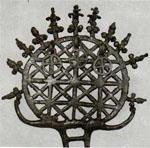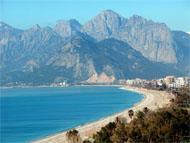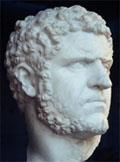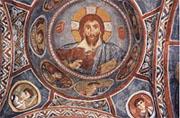Humankind, who had been living as hunter-gatherers for tens of thousands of years, began to live in sedentary life
style in the Near East for about 11.000 years ago. This was towards the end of the last Ice Age. During this era humans domesticated some animals and plants and this lead to the occurrence of the
first steps of “state”. We call this period as “the Neolithic Revolution”[1]. It has been believed that Canaan-Palestine regions as well as Syria and Iraq were the
centers of the first signs of the Neolithic Revolution. However, excavations which have been carried out recently at Göbeklitepe near Şanlıurfa in southeastern Turkey, illustrate
us that humankind constructed temple like structures before the sedentary life style [2]. Archaeological excavations moreover, are carried out in the Marmaray Project (undersea railway system in
the Bosphorus) in İstanbul. And these works prove us that the past of İstanbul goes back much before than we previously thought.[3]
The following millennia are the Chalcolithic (ca. 5500-3000) and the Bronze Ages (ca. 3000-1100 BC) after the Neolithic period. Anatolia became the land of sedentary peoples in these periods.
There are thousands of ancient settlements in Turkey; from Çatalhöyük[4] near Konya-Çumra to Hacılar in Burdur province, from Demircihöyük Eskişehir to
thousands of other “höyüks” (artificial mounds) which some of them are still unexamined or even unnamed. Especially,
Gaziantep-Antakya-Şanlıurfa-Diyarbakır-Mardin regions (southeast Turkey) show us that Anatolia was densely settled and later became the motherland of the Hittites in the Bronze Age
[5].
Thanks to the Assyrian merchants, Anatolia met the writing system between 2000-1750 BC. The Hittite Kingdom and later the Hittite Empire was the super power of the era [6]. They signed the
first written treaty in the world with the Egyptians which is called the Qadesh Treaty and its tablet written in the Hittite cuneiform script is now in the İstanbul Archaeology Museum.
Hattusa was their capital in Çorum Province, central Turkey and excavations are still carried out to find the unknowns about this civilization [7].
The Urartians had the capital Tuspa near the Lake Van , the Phrygians with the capital Gordion (Polatlı-Yassıhöyük) in central Anatolia and the Lydians with their capital
Sardis in western Turkey who invented coinage. These were the major civilizations of the Iron Age Anatolia. By the beginning of 6th century BC, the Persians took the control of the major parts of
Anatolia and they ruled for around 200 years. In 333 BC Alexander the Great won the Battle of Issos against the Persian King Darius, therefore the Hellenistic Period began in these lands [8].
Anatolia became a part of the Roman Empire in the end of the 2nd century BC. Rome which was ruled by the Caesars was the strongest and the most well organized empire the world had ever seen. Its
borders reached from Spain to Iran, from the Black Sea coasts of Turkey to the southern Egypt and till the northern parts of Britain [9]. Anatolia was left to the Republic of Rome by the king
Attalos III of Pergamon in 133 BC. Thus the Roman Age began. [10]. The Kuşkayası Roman Road monument at Amasra, the theater of Patara, the Celsus Library at Ephesus, the Cendere Bridge
at Adıyaman - Kahta in southeastern Turkey are only some traces of the Roman civilization in Anatolia.
After the division of the Roman Empire as East and West, the Byzantine Empire (the Eastern Roman Empire) spread in Anatolia and in this period Christianity became a major religion.
Constantinople, today’s İstanbul was the capital of the empire and this continued for about 1000 years till Mehmet the Conqueror took the control of the city in 1453. During this
period the city was the center of the Eastern Church. [11] Hagia Sophia, the Cistern Basilica, Hagia Irine and many other monumental buildings were constructed in the Byzantine period and
still being visited by thousands of tourists.
The attacks began in the 11th century by the Turks created a new era. Turkish-Islamic culture was spread by the new comers to the land after the Battle of Manzikert in 1071 [12]. The Seljuk
Empire had the capital in Konya, in central Anatolia and its rulers governed the state from this highly developed city of the time. Other feudal states of the period called “beylik”
in Turkish, ruled the penninsula from Erzurum in the east to Muğla in the west, and those "beyliks" spread Turkish presence in all over Anatolia.
A clan of the Kayı tribe of the Oghuz Turks came to the Söğüt-Domaniç region (in north western Turkey) where was given to them by the Seljuk Sultan Aladdin in 1231
[13]. When their leader Ertuğrul Bey died in 1281, this clan or feudal state had 4800 km² land in Karacadağ, Söğüt and Domaniç region in north western
Turkey. Later in 1595, this state reached the land size of around 20.000.000 km² in Asia, Africa and Europe and became a world empire. 100 million people were living in these lands and at
that time the world’s total population was about 540 million [14]. The Ottoman Empire left a great heritage in the world’s historical, cultural and religious structure.
At the end of the 19th century this state was on the razor’s edge. The Ottoman Empire was in agony economically, politically and culturally. After the First World War the state was in the
destruction process and signed the Sèvres treaty on 10th August 1920 with the Allies of the First World War. According to this treaty the presence of the Turkish Rule for about 850 years in
Anatolia was ending [15]. However, Mustafa Kemal Atatürk and his military comrades did not accept this treaty and they started the Independence War against the occupants. Atatürk was
successful by defeating the Greek invaders in the west and he established a new state system; the Turkish Republic on 29th October 1923. This was a revolution from a theocratic monarchy to a
secular republic. The parliamentary system led the modernization of the country in equal rights of men and women, acceptance of the Latin alphabet, new civil law and the union of education and
much more revolutions were done. A new period started in Anatolia with the Republic of Turkey.
[1] Roux, G. 1992. Ancient Iraq (pp.33-42) Penguin Books, New York.
[2] http://ntv-msnbc.com.tr/news/375759.asp
[3] http://hurarsiv.hurriyet.com.tr/goster/haber.aspx?id=10027341&tarih=2008-10-02
[4] Hodder, I. 2006. Çatalhöyük Leoparın Öyküsü: Türkiye’nin Antik “Kasabasının” Gizemleri
Günışığına Çıkıyor (pp.7). Yapı Kredi Kültür Sanat, İstanbul.
[5] Macqueen, J.G. 2001. Hititler ve Hitit Çağında Anadolu (pp.34-40). Thames & Hudson, Londra.
[6] Ünal, A. 2002. Hititler Devrinde Anadolu (pp 65-75). Arkeoloji ve Sanat Yayınları, İstanbul.
[7] Macqueen, J.G. 2001. Hititler ve Hitit Çağında Anadolu (pp.52-53). Thames & Hudson, Londra.
[8] Ramage&Ramage, 1995. Roman Art (pp 84-85). Laurance King Publishing, London
[9] Ramage&Ramage, 1995. Roman Art (pp 8-14). Laurance King Publishing, London
[10] Kosmetatou, E., (2003) "The Attalids of Pergamon," in Andrew Erskine, ed., A Companion to the Hellenistic World. Oxford: Blackwell: pp. 159-174
[11] Honour, H. & Fleming, J., 1995: A World History of Art (pp. 284-290). Laurance King Publishing, London.
[12] Yazıcı, N. (2006) “Anadolu’da Kurulan ilk Türk Devletleri” in Öztürk, C., ed. Türk Tarihi ve Kültürü. Ankara, Pegem
Yayıncılık: pp. 57-58.
[13] Oral, E. (2006) “Osmanlı İmparatorluğu” in Öztürk, C., ed. Türk Tarihi ve Kültürü. Ankara, Pegem Yayıncılık: pp.
107-108.
[14] Oral, E. (2006) “Osmanlı İmparatorluğu” in Öztürk, C., ed. Türk Tarihi ve Kültürü. Ankara, Pegem Yayıncılık:
pp.115.
[15] Öztürk, C. (2006) “Türkiye Cumhuriyeti (1923-1950)” in Öztürk, C., ed. Türk Tarihi ve Kültürü. Ankara, Pegem
Yayıncılık: pp.141-142.





Anatolia in Brief
by
Onur Ertürk
Onur Ertürk
Professional Tour Guide - Archaeologist
www.rehberonur.com
copyright 2008-2023
contact: onur@rehberonur.com





